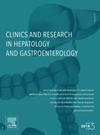Metabolic dysfunction-associated steatotic liver disease (MASLD): Exploring systemic impacts and innovative therapies
IF 2.4
4区 医学
Q2 GASTROENTEROLOGY & HEPATOLOGY
Clinics and research in hepatology and gastroenterology
Pub Date : 2025-03-27
DOI:10.1016/j.clinre.2025.102584
引用次数: 0
Abstract
Metabolic dysfunction-associated steatotic liver disease (MASLD), which includes the inflammatory subtype metabolic dysfunction-associated steatohepatitis, is a prominent cause of chronic liver disease with systemic effects. Insulin resistance, obesity, and dyslipidaemia produce MASLD in over 30 % of adults. It is a global health issue. From MASLD to MASH, hepatic inflammation and fibrosis grow, leading to cirrhosis, hepatocellular cancer, and extrahepatic complications such CVD, CKD, and sarcopenia. Effects of MASLD to MASH are mediated through mechanisms that include inflammation, oxidative stress, dysbiosis, and predisposition through genetic makeup. Advances in diagnostic nomenclature in the past few years have moved the emphasis away from NAFLD to MASLD, focusing on the metabolic etiology and away from the stigma of an alcoholic-related condition. Epidemiological data show a large geographical variability and increasing prevalence in younger populations, particularly in regions with high carbohydrate-rich diets and central adiposity. Lifestyle modification is considered as the main management of MASLD currently. This may include dietary intervention, exercise, and weight loss management. Pharmaceutical management is primarily aimed at metabolic dysfunction with promising findings for GLP-1 receptor agonists, pioglitazone and SGLT-2 inhibitors, which can correct both hepatic and systemic outcome. However, it still depends on well-integrated multidisciplinary care models by considering complex relationships between MASLD and its effects on extrahepatic organs. Determining complications at an early stage; developing precision medicine strategies; exploring new therapeutic targets will represent crucial factors in improving their outcomes. This review discuss the systemic nature of MASLD and calls for multiple collaborations to reduce its far-reaching health impacts and our quest for understanding its pathological mechanisms. Thus, collective efforts that are required to address MASLD are under the public health, clinical care, and research angles toward effectively containing its rapidly increasing burden.
代谢功能障碍相关性脂肪肝(MASLD):探索系统性影响和创新疗法。
代谢功能障碍相关脂肪性肝病(MASLD),包括炎症亚型代谢功能障碍相关脂肪性肝炎,是一种具有全身性影响的慢性肝病的重要病因。胰岛素抵抗、肥胖和血脂异常在超过30%的成年人中产生MASLD。这是一个全球性的健康问题。从MASLD到MASH,肝脏炎症和纤维化增加,导致肝硬化、肝细胞癌和肝外并发症,如CVD、CKD和肌肉减少症。MASLD对MASH的影响是通过炎症、氧化应激、生态失调和基因构成的易感性等机制介导的。在过去几年中,诊断术语的进步已经将重点从NAFLD转移到MASLD,关注代谢病因,远离酒精相关疾病的耻辱。流行病学数据显示存在很大的地理差异,在年轻人群中患病率不断上升,特别是在高碳水化合物饮食和中枢性肥胖的地区。生活方式改变是目前治疗MASLD的主要方法。这可能包括饮食干预、运动和减肥管理。药物管理主要针对代谢功能障碍,GLP-1受体激动剂,吡格列酮和SGLT-2抑制剂有希望的发现,可以纠正肝脏和全身的结局。然而,考虑到MASLD及其对肝外器官的影响之间的复杂关系,它仍然依赖于良好整合的多学科护理模式。早期确定并发症;制定精准医疗战略;探索新的治疗靶点将是改善其结果的关键因素。这篇综述讨论了MASLD的系统性,并呼吁多方合作以减少其深远的健康影响和我们对其病理机制的理解。因此,在公共卫生、临床护理和研究的角度下,解决MASLD所需的集体努力是为了有效地遏制其迅速增加的负担。
本文章由计算机程序翻译,如有差异,请以英文原文为准。
求助全文
约1分钟内获得全文
求助全文
来源期刊

Clinics and research in hepatology and gastroenterology
GASTROENTEROLOGY & HEPATOLOGY-
CiteScore
4.30
自引率
3.70%
发文量
198
审稿时长
42 days
期刊介绍:
Clinics and Research in Hepatology and Gastroenterology publishes high-quality original research papers in the field of hepatology and gastroenterology. The editors put the accent on rapid communication of new research and clinical developments and so called "hot topic" issues. Following a clear Editorial line, besides original articles and case reports, each issue features editorials, commentaries and reviews. The journal encourages research and discussion between all those involved in the specialty on an international level. All articles are peer reviewed by international experts, the articles in press are online and indexed in the international databases (Current Contents, Pubmed, Scopus, Science Direct).
Clinics and Research in Hepatology and Gastroenterology is a subscription journal (with optional open access), which allows you to publish your research without any cost to you (unless you proactively chose the open access option). Your article will be available to all researchers around the globe whose institution has a subscription to the journal.
 求助内容:
求助内容: 应助结果提醒方式:
应助结果提醒方式:


